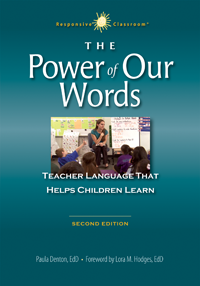Teacher Word Choice Impacts Student Learning
The Power of Our Words: Teacher Language That Helps Children Learn, 2nd Edition
By Paula Denton, EdD
(Responsive Classroom., 2014 – Learn more)

Both new and experienced teachers will find something valuable to reflect upon in The Power of Our Words. Most professional development books are geared towards a specific subset of teachers. This book would be thought-provoking to read no matter what grade level or subject area you teach.

When I was in the classroom, I had moments where my attempts to redirect a child failed to work – or worse, seemed to amplify the problem. As a math teacher, I struggled to get students to persevere through a problem and to make connections on their own without looking to me or a calculator for the answer. The Power of Our Words gave me insight into how slightly altering the way I said things could make what I said more effective.
My favorite parts of the book
One of the chapters I found the most intriguing was the one on envisioning language. The author suggests three steps in formulating effective vision statements. First, think about your values or students’ values as they relate to the current situation. Second, articulate to yourself a specific and concrete goal that reflects this value. Third, talk about these aspirations with ideas and words that engage children.
For example, Denton discusses a group of students she had taught who spent more time arguing about Capture the Flag than playing it. She started by asking students why they enjoyed playing the game. She then restated the reasons they liked to play and asked them how they could settle their disputes so they could get back to having fun. Instead of telling the kids to quit bickering, she found a way to tap into what was important to them and ask them to solve their own problem so they could get back to playing the game.
Denton has great suggestions for the problems that can arise when you ask an open-ended question.
The new Common Core standards are designed to push students to think critically and to problem solve. Denton’s chapter on open-ended questions can help teachers push students to think deeper. She has great suggestions for the problems that can arise when you ask an open-ended question. She reminds teachers to be sure to include the boundaries when asking open-ended questions.
For example: Instead of, “what do you notice about this story?”, a teacher can ask, “what do you notice about this story that is similar to other stories we’ve read?” She also encourages teachers to use language that prompts multiple answers such as “What are different ways we can… What are other possible reasons….” This type of language invites multiple students to respond.
Paula Denton believes students should learn self-control. For students to learn self-control they must have a sense of autonomy, and the language we tend to use as teachers focuses on compliance. As teachers, we want students to be self-motivated and to solve their own problems, yet we often use language that encourages students to do things to make us happy. For example, instead of saying to a student “I love how careful you are being with the classroom supplies,” a teacher could say “You handled the supplies carefully so nothing would break.” The difference is subtle but important.
How to shift your teacher language
I also appreciated Appendix B, The Process of Developing More Effective Teacher Language. In it, Denton reminds us that change is difficult. She encourages teachers to start small. If you catch yourself saying something ineffective, pause and rephrase it. Create a reminder card with key words to carry with you or display in your classroom as a reminder. She also encourages teachers to work as a team on one aspect of their language.
I found Denton’s book thought provoking. The small shifts in language she suggests can help teachers push their students to take more ownership over their own choices and learning. It can also help teachers find ways to help students learn self-control without focusing on compliance. I think all educators will find at least one aspect of their “teacher language” to reflect on after reading this book.
Jennifer Jankowski taught middle school math for 10 years. She is currently working for the University of Chicago Center for Elementary Math and Science Education on curriculum development. She lives in Chicago, IL.

































